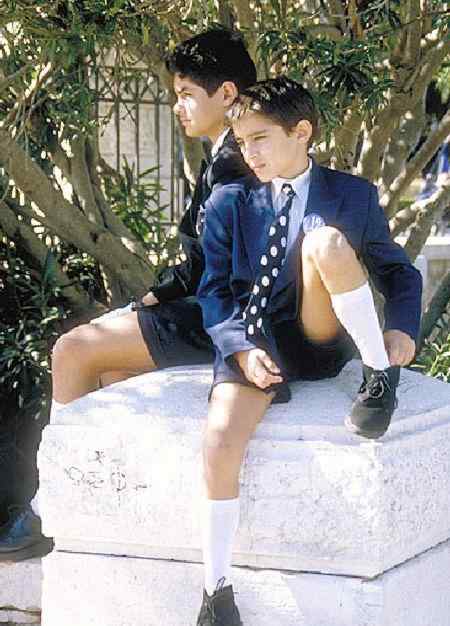
Figure 1.--These boys on Stoliparelasis Island are having a rest after the annual Independence Day parade. They wear blazers, ties, short pants, white kneesocks, and black leather shoes. |

|
Greek school children wear uniforms for important annual parades. Students parade in the main street of the city along with soldiers, boyscouts, police forces, war heroes, red cross nurses etc. In small villages that do not have soldiers, police forces etc. there is only a small student parade. Since the 50s the parade is not only an event of the Independence Day (March 25), but also of the "Ochi" day (October 28). Students of 5th and 6th grade of elementary schools and selected students of high schools do a parade on those two days. All participating students must wear a uniform which is determined by the board of the school. The uniform items always had to be be blue and white--the Greek national colors. The student with the best grades in school has the honor to parade by holding the flag. He is also wearing white gloves. The next five best students parade next and just beside him.
Students parade in the main street of the city along with soldiers, boyscouts, police forces, war heroes, red cross nurses etc. In small villages that do not have soldiers, police forces etc. there is only a small student parade. Students of 5th and 6th grade of elementary schools and selected students of high schools do a parade on those two days. All participating students must wear a uniform which is determined by the board of the school. The uniform items always had to be be blue and white--the Greek national colors.
Schools and the military do a parade twice a year. At Independence Day (March 25) and Ochi Day, "No Day," remembering the Greek resistance of World War II, (October 28).
Boys and girls must wear a uniform for the parade. For the Independence day
the kilt is also an option. During the years of the school uniform, students used to parade by simply wearing their uniform. After 1982, with the abolishment of the "scholiki podia" (school uniform) teacher and school authorities found a different way to present their students uniformed in the parade. Each school board decides about the garments that will consist a special uniform to be weared by boys and girls during the parade. The only
requirement is that all garments should be either blue or white (the colors
of the Greek flag). The garments used are: Blue shorts, blue long trousers, white shirts, white sweaters, blue blazers, blue ties, blue neckerchiefs, blue bowties, blue
berets, white ankle socks, white kneesocks and black shoes. As you can imagine there are several dozens possible variations that are used by schools around Greece. Students must also wear the badge of their school on the left of their chest. Up until the early 1990s most elementary schools chose short pants for the boys but nowdays almost all schools choose long trousers. For the senior secondary school students, the most usual uniform is long trousers, with shirt and tie.
The student with the best grades in school has the honor to parade by holding the flag. He is also wearing white gloves. The next five best students parade next and just beside him. Then the rest of the students parade in groups of boys and girls with the tallest students in front.
A HBC reader reports, "The only personal memory of school uniform I have is at parade days. I had to parade as a 5th and 6th grader at October 28. I remember my school's uniform was consisted of short blue shorts, black or blue shoes, white dress ankle socks, a white sweater and the school's badge. I remember that it felt weird having to wear shorts during a chilly October morning. I didnt think of it back then but now I realise that the parade clothes were actually a uniform. I never saw it as a uniform until now. Maybe because it was only a one-time deal." Gymnastic demonstrations were something very popular during the 1960s-70s. At the last day of the year children did a kind of gymnastic demonstration. They all wear predetermined clothing (always in the national colors of blue and white).
Related Chronolgy Pages in the Boys' Historical Web Site
[The 1880s]
[The 1930s]
[The 1940s]
[The 1930s]
[The 1940s]
[The 1950s]
[The 1960s]
[The 1970s]
[The 1980s]
Related Style Pages in the Boys' Historical Web Site
[Long pants suits]
[Short pants suits]
[Socks]
[Eton suits]
[Jacket and trousers]
[Blazer]
[School sandals]
Navigate the Boys' Historical Clothing Web Page
[Return to Main Greek school activities page]
[Return to Main Greek school uniform page]
[Return to Main national school uniform page]
[Return to Main Greek page]
[About Us]
[Activities]
[Chronology]
[Clothing styles]
[Countries]
[Debate]
[Economics]
[Garment]
[Gender]
[Hair]
[History]
[Home trends]
[Literary characters]
[School types]
[Significance]
[Transport and travel
[Uniform regulations]
[Year level]
[Other topics]
[Images]
[Links]
[Registration]
[Tools]
[Return to the Historic Boys' School Home]
